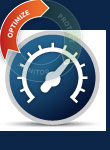 Recently, Forbes, Mashable and ZDNet have reported at length about the relationship between ecommerce site speed and revenue, noting that site speed has a significant impact on bottom lines. Shoppers start dropping off if they have to wait much longer than two to four seconds for a page to load. Despite this, some ecommerce retailers are taking a wait-and-see approach rather than investing in upgrading site speed. This could be due to a misconception among independent retailers that a huge investment in time and resources would be required, according to Bob Buffone, CTO and co-founder of Yottaa, a web optimization solution. “This is simply not true. Independent retailers today have access to a number of low cost resources that can help turn any ecommerce site into a speed demon ready to go up against the big players.”
Recently, Forbes, Mashable and ZDNet have reported at length about the relationship between ecommerce site speed and revenue, noting that site speed has a significant impact on bottom lines. Shoppers start dropping off if they have to wait much longer than two to four seconds for a page to load. Despite this, some ecommerce retailers are taking a wait-and-see approach rather than investing in upgrading site speed. This could be due to a misconception among independent retailers that a huge investment in time and resources would be required, according to Bob Buffone, CTO and co-founder of Yottaa, a web optimization solution. “This is simply not true. Independent retailers today have access to a number of low cost resources that can help turn any ecommerce site into a speed demon ready to go up against the big players.”
Buffone offers the following tips to help online retailers boost site speed:
Establish a baseline and set up monitoring for key pages.
Before making any website changes, independent retailers should take the time to establish a baseline and monitor web performance before and after any changes are made. An ideal monitoring tool gives real user data and presents the actual browser-specific user experience for all ecommerce pages. This tool should be capable of correlating the page rendering process with specific numerical measurements, allowing retailers to quantify the potential impact of any site changes.
Pay attention to images and widgets.
Independent retailers need alluring images of their products to sell, but in the last nine years the size of the average web page has increased over tenfold (from 94KB to 679KB). Since images are generally the largest assets of a website, they present the greatest opportunity for optimization. Today there are many ways to compress images without reducing quality, and numerous tools for doing so, including Yahoo!’s Smush.it.
In addition to appealing product images, social media widgets like Facebook, Pinterest and Twitter are considered staples for most independent retailers looking to increase virality. But third-party widgets can slow a site to a standstill. Independent retailers should look into minimizing the number of third-party widgets used on their site, and be sure to load any widgets asynchronously, meaning that their loading doesn’t delay other operations on the web page.
Take advantage of high quality, free advice.
There are plenty of free how-to resources that can help retailers increase site speed with minimal time and resource constraints. Perfplanet, SitePoint and Smashing Magazine offer some of the best strategies and resource recommendations for independent retailers on this issue.
